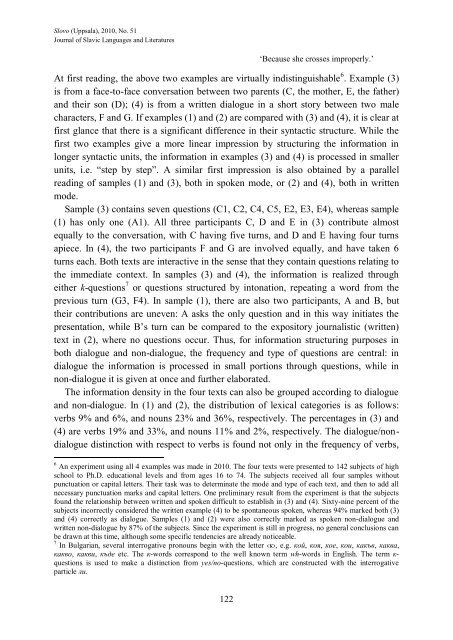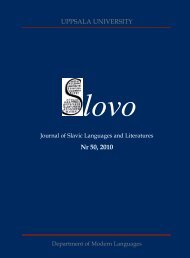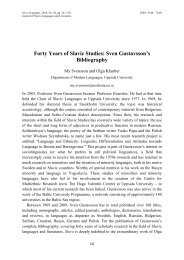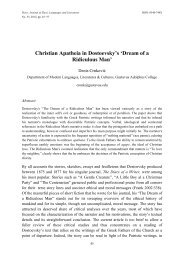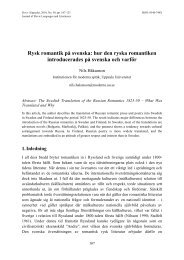Slovo (<strong>Uppsala</strong>), 2010, No. 51Journal <strong>of</strong> Slavic Languages and Literatures„Because she crosses improperly.‟At first reading, the above two examples are virtually indistinguishable 6 . Example (3)is from a face-to-face conversation between two parents (C, the mother, E, the father)and their son (D); (4) is from a written dialogue in a short story between two malecharacters, F and G. If examples (1) and (2) are compared with (3) and (4), it is clear atfirst glance that there is a significant difference in their syntactic structure. While thefirst two examples give a more linear impression by structuring the information inlonger syntactic units, the information in examples (3) and (4) is processed in smallerunits, i.e. “step by step”. A similar first impression is also obtained by a parallelreading <strong>of</strong> samples (1) and (3), both in spoken mode, or (2) and (4), both in writtenmode.Sample (3) contains seven questions (C1, C2, C4, C5, E2, E3, E4), whereas sample(1) has only one (A1). All three participants C, D and E in (3) contribute almostequally to the conversation, with C having five turns, and D and E having four turnsapiece. In (4), the two participants F and G are involved equally, and have taken 6turns each. Both texts are interactive in the sense that they contain questions relating tothe immediate context. In samples (3) and (4), the information is realized througheither k-questions 7 or questions structured by intonation, repeating a word from theprevious turn (G3, F4). In sample (1), there are also two participants, A and B, buttheir contributions are uneven: A asks the only question and in this way initiates thepresentation, while B‟s turn can be compared to the expository journalistic (written)text in (2), where no questions occur. Thus, for information structuring purposes inboth dialogue and non-dialogue, the frequency and type <strong>of</strong> questions are central: indialogue the information is processed in small portions through questions, while innon-dialogue it is given at once and further elaborated.The information density in the four texts can also be grouped according to dialogueand non-dialogue. In (1) and (2), the distribution <strong>of</strong> lexical categories is as follows:verbs 9% and 6%, and nouns 23% and 36%, respectively. The percentages in (3) and(4) are verbs 19% and 33%, and nouns 11% and 2%, respectively. The dialogue/nondialoguedistinction with respect to verbs is found not only in the frequency <strong>of</strong> verbs,6 An experiment using all 4 examples was made in 2010. The four texts were presented to 142 subjects <strong>of</strong> highschool to Ph.D. educational levels and from ages 16 to 74. The subjects received all four samples withoutpunctuation or capital letters. Their task was to determinate the mode and type <strong>of</strong> each text, and then to add allnecessary punctuation marks and capital letters. One preliminary result from the experiment is that the subjectsfound the relationship between written and spoken difficult to establish in (3) and (4). Sixty-nine percent <strong>of</strong> thesubjects incorrectly considered the written example (4) to be spontaneous spoken, whereas 94% marked both (3)and (4) correctly as dialogue. Samples (1) and (2) were also correctly marked as spoken non-dialogue andwritten non-dialogue by 87% <strong>of</strong> the subjects. Since the experiment is still in progress, no general conclusions canbe drawn at this time, although some specific tendencies are already noticeable.7 In Bulgarian, several interrogative pronouns begin with the letter ‹к›, e.g. кой, коя, кое, кои, какъв, каква,кaкво, какви, къде etc. The к-words correspond to the well known term wh-words in English. The term к-questions is used to make a distinction from yes/no-questions, which are constructed with the interrogativeparticle ли.122
Daniela AssenovaSpoken vs. Written or Dialogue vs. Non-Dialogue…but also in verb types. In (1) and (2), most <strong>of</strong> the verbs are transitive (разтвори, даде,получи etc, отговаря, установи, достигна etc) and in reflexive form (се развива, сеизперат, се легализират) while in (3) and (4) intransitive and modal verbs arepreferred. Thus, in the giving <strong>of</strong> information in non-dialogue, syntactic structures withtwo overt referents subject and object, are needed, while for the interactive text types,in dialogue, one referent is <strong>of</strong>ten enough. Moreover, when the referent is one <strong>of</strong> thespeech act participants, it is incorporated in the personal ending <strong>of</strong> the verb (notice thefrequency <strong>of</strong> verb forms for first and second person in examples (3) and (4)). When thereferent is not one <strong>of</strong> the speech act participants, structures with the copula verb съмare preferred (compare the frequency <strong>of</strong> the verb съм in (3) and (4) with its occurrencein (1) and (2)).The differences between (1) and (2), and between (3) and (4), are also expressedthrough the use <strong>of</strong> PPs. In the non-dialogue texts, the number <strong>of</strong> PPs is higher, and theyare used preferably as modifiers in the NPs (икономическото развитие следдвехиляди и първа година, тази ножица между много бедни и много богати,личният двубой на кмета с "Енел", сламени кукли с образите на дваматашефове на "Енел" – Майк Фостър и Енрико Виале), while in the dialogue texts, thenumber <strong>of</strong> PPs is lower, and they are either “free” (До това в Сараево), or related tothe V by giving additional information as adverbial (да говориш като нормаленчовек, е с кола).Thus dialogue and non-dialogue can be distinguished in respect to the frequency <strong>of</strong>V, N and PPs. According to Biber (1988:13) the structuring <strong>of</strong> information leads to the“co-occurrence” <strong>of</strong> linguistic features and their frequency is grounded in the functionalcharacteristics <strong>of</strong> different types <strong>of</strong> texts, described as dimensions <strong>of</strong> variations amongspoken and written English. Moreover, in Biber (2004:21) the author presents resultsthat conversations tend to be “either „informational‟ or „interactive‟ but not both”. Inhis study this is referred as informational-focused vs. interactive discourse.Figure 2 below shows the frequency <strong>of</strong> Vs, Ns and PPs when the focus is on mode(i.e., written vs. spoken language), Figure 3 shows the results for text type (i.e., nondialoguevs. dialogue), and Figure 4 shows the results when the texts are distinguishedaccording to both mode and type. The numerals in the figures represent average valuesfor the different categories: for example, the result labeled “play” gives the averagevalue for all nine plays that were included, while the result for “TV-talk-show” givesthe average value for all 4 talk-shows, etc.123
- Page 1 and 2:
UPPSALA UNIVERSITYlovoJournal of Sl
- Page 3:
CONTENTSEDITORIAL: SLOVO ARAUND THE
- Page 6 and 7:
Slovo (Uppsala), 2010, No. 51Journa
- Page 8 and 9:
Slovo (Uppsala), 2010, No. 51Journa
- Page 10 and 11:
Slovo (Uppsala), 2010, No. 51Journa
- Page 12 and 13:
Slovo (Uppsala), 2010, No. 51Journa
- Page 14 and 15:
Slovo (Uppsala), 2010, No. 51Journa
- Page 16 and 17:
Slovo (Uppsala), 2010, No. 51Journa
- Page 18 and 19:
Slovo (Uppsala), 2010, No. 51Journa
- Page 20 and 21:
Slovo (Uppsala), 2010, No. 51Journa
- Page 22 and 23:
Slovo (Uppsala), 2010, No. 51Journa
- Page 24 and 25:
Slovo (Uppsala), 2010, No. 51Journa
- Page 26 and 27:
Slovo (Uppsala), 2010, No. 51Journa
- Page 29 and 30:
Alexander I. Pereswetoff-MorathIsaa
- Page 31 and 32:
Alexander I. Pereswetoff-MorathIsaa
- Page 33 and 34:
Alexander I. Pereswetoff-MorathIsaa
- Page 35 and 36:
Slovo (Uppsala), 2010, No. 51, pp.
- Page 37 and 38:
Juhani NuorluotoIzvori za prouĉava
- Page 39 and 40:
Juhani NuorluotoIzvori za prouĉava
- Page 41 and 42:
Juhani NuorluotoIzvori za prouĉava
- Page 43 and 44:
Juhani NuorluotoIzvori za prouĉava
- Page 45 and 46:
Juhani NuorluotoIzvori za prouĉava
- Page 47 and 48:
Juhani NuorluotoIzvori za prouĉava
- Page 49 and 50:
Juhani NuorluotoIzvori za prouĉava
- Page 51 and 52:
Juhani NuorluotoIzvori za prouĉava
- Page 53:
Juhani NuorluotoIzvori za prouĉava
- Page 56 and 57:
Slovo (Uppsala), 2010, No. 51Journa
- Page 58 and 59:
Slovo (Uppsala), 2010, No. 51Journa
- Page 60 and 61:
Slovo (Uppsala), 2010, No. 51Journa
- Page 62 and 63:
Slovo (Uppsala), 2010, No. 51Journa
- Page 64 and 65:
Slovo (Uppsala), 2010, No. 51Journa
- Page 66 and 67:
Slovo (Uppsala), 2010, No. 51Journa
- Page 68 and 69:
Slovo (Uppsala), 2010, No. 51Journa
- Page 71 and 72:
Slovo (Uppsala), 2010, No. 51, pp.
- Page 73 and 74: Никита МихайловО м
- Page 75 and 76: Никита МихайловО м
- Page 77 and 78: Никита МихайловО м
- Page 79 and 80: Никита МихайловО м
- Page 81 and 82: Никита МихайловО м
- Page 83: Никита МихайловО м
- Page 86 and 87: Slovo (Uppsala), 2010, No. 51Journa
- Page 88 and 89: Slovo (Uppsala), 2010, No. 51Journa
- Page 90 and 91: Slovo (Uppsala), 2010, No. 51Journa
- Page 92 and 93: Slovo (Uppsala), 2010, No. 51Journa
- Page 94 and 95: Slovo (Uppsala), 2010, No. 51Journa
- Page 97 and 98: Slovo (Uppsala), 2010, No. 51, pp.
- Page 99 and 100: Карине Окерман Сар
- Page 101 and 102: Карине Окерман Сар
- Page 103 and 104: Карине Окерман Сар
- Page 105 and 106: Карине Окерман Сар
- Page 107 and 108: Карине Окерман Сар
- Page 109 and 110: Slovo (Uppsala), 2010, No. 51, pp.
- Page 111 and 112: P. Ambrosiani, A. GranbergSlavonica
- Page 113 and 114: P. Ambrosiani, A. GranbergSlavonica
- Page 115: Stockholm, The Strindberg Museum (S
- Page 118 and 119: Slovo (Uppsala), 2010, No. 51Journa
- Page 120 and 121: Slovo (Uppsala), 2010, No. 51Journa
- Page 122 and 123: Slovo (Uppsala), 2010, No. 51Journa
- Page 126 and 127: Slovo (Uppsala), 2010, No. 51Journa
- Page 128 and 129: Slovo (Uppsala), 2010, No. 51Journa
- Page 131 and 132: Slovo (Uppsala), 2010, No. 51, pp.
- Page 133 and 134: Мария ЭнгстремАпоф
- Page 135 and 136: Мария ЭнгстремАпоф
- Page 137 and 138: Мария ЭнгстремАпоф
- Page 139 and 140: Мария ЭнгстремАпоф
- Page 141 and 142: Мария ЭнгстремАпоф
- Page 143 and 144: Slovo (Uppsala), 2010, No. 51, pp.
- Page 145 and 146: Ingrid MaierRecension: Tore Nesset:
- Page 147 and 148: Ingrid MaierRecension: Tore Nesset:
- Page 149 and 150: Ingrid MaierRecension: Tore Nesset:
- Page 151: Slovo (Uppsala), 2010, No. 51, pp.


